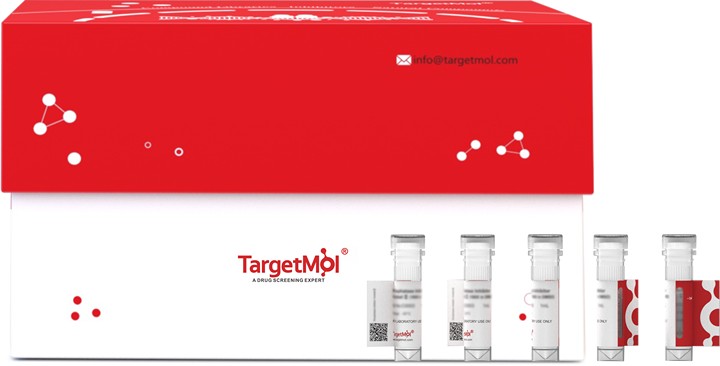- 全部删除
 您的购物车当前为空
您的购物车当前为空
Lpp Protein, E. coli, Recombinant (His & KSI)
An outer membrane lipoprotein that controls the distance between the inner and outer membranes; adding residues to Lpp increases the width of the periplasm. The only protein known to be covalently linked to the peptidoglycan network (PGN). Also non-covalently binds the PGN. The link between the cell outer membrane and PGN contributes to the maintenance of the structural and functional integrity of the cell envelope, and maintains the correct distance between the PGN and the outer membrane. The most abundant cellular protein in terms of copy number, there can be up to one million Lpp molecules per cell. About one-third of Lpp is bound to the PGN (called bound or periplasmic) the rest is called free or transmembrane. The 'free' form can be surface labeled by membrane impermeable agents and so must cross the outer membrane; it is thought that this transmembrane form is still anchored in the inner leaflet of the outer membrane. Modeling suggests that non-covalent binding of OmpA (from the outer membrane) and TolR (from the inner membrane) to peptidoglycan maintains the position of the cell wall in the periplasm, holding it approximately equidistant from both the inner and outer membranes. Trimeric Lpp controls the width of the periplasm, adjusts its tilt angle to accommodate to the available space, and can compensate in part for an absence of OmpA (Probable). The role of the cell surface-exposed, free form (transmembrane) of Lpp is unknown.

Lpp Protein, E. coli, Recombinant (His & KSI)
| 规格 | 价格 | 库存 | 数量 |
|---|---|---|---|
| 20 μg | ¥ 2,290 | 20日内发货 | |
| 100 μg | ¥ 4,750 | 20日内发货 | |
| 1 mg | ¥ 16,000 | 20日内发货 |
产品信息
| 生物活性 | Activity has not been tested. It is theoretically active, but we cannot guarantee it. If you require protein activity, we recommend choosing the eukaryotic expression version first. |
| 产品描述 | An outer membrane lipoprotein that controls the distance between the inner and outer membranes; adding residues to Lpp increases the width of the periplasm. The only protein known to be covalently linked to the peptidoglycan network (PGN). Also non-covalently binds the PGN. The link between the cell outer membrane and PGN contributes to the maintenance of the structural and functional integrity of the cell envelope, and maintains the correct distance between the PGN and the outer membrane. The most abundant cellular protein in terms of copy number, there can be up to one million Lpp molecules per cell. About one-third of Lpp is bound to the PGN (called bound or periplasmic) the rest is called free or transmembrane. The 'free' form can be surface labeled by membrane impermeable agents and so must cross the outer membrane; it is thought that this transmembrane form is still anchored in the inner leaflet of the outer membrane. Modeling suggests that non-covalent binding of OmpA (from the outer membrane) and TolR (from the inner membrane) to peptidoglycan maintains the position of the cell wall in the periplasm, holding it approximately equidistant from both the inner and outer membranes. Trimeric Lpp controls the width of the periplasm, adjusts its tilt angle to accommodate to the available space, and can compensate in part for an absence of OmpA (Probable). The role of the cell surface-exposed, free form (transmembrane) of Lpp is unknown. |
| 种属 | E. coli |
| 表达系统 | E. coli |
| 标签 | N-6xHis-KSI |
| 蛋白编号 | P69776 |
| 别名 | Murein-lipoprotein,mulI,mlpA,Major outer membrane lipoprotein Lpp,lpp,Braun lipoprotein (BLP) |
| 氨基酸序列 | CSSNAKIDQLSSDVQTLNAKVDQLSNDVNAMRSDVQAAKDDAARANQRLDNMATKYRK |
| 蛋白构建 | 21-78 aa |
| 蛋白纯度 | > 85% as determined by SDS-PAGE. |
| 分子量 | 21.8 kDa (predicted) |
| 内毒素 | < 1.0 EU/μg of the protein as determined by the LAL method. |
| 缓冲液 | Tris-based buffer, 50% glycerol |
| 复溶方法 | A Certificate of Analysis (CoA) containing reconstitution instructions is included with the products. Please refer to the CoA for detailed information. |
| 存储 | Lyophilized powders can be stably stored for over 12 months, while liquid products can be stored for 6-12 months at -80°C. For reconstituted protein solutions, the solution can be stored at -20°C to -80°C for at least 3 months. Please avoid multiple freeze-thaw cycles and store products in aliquots. |
| 运输方式 | In general, Lyophilized powders are shipping with blue ice. Solutions are shipping with dry ice. |
| 研究背景 | An outer membrane lipoprotein that controls the distance between the inner and outer membranes; adding residues to Lpp increases the width of the periplasm. The only protein known to be covalently linked to the peptidoglycan network (PGN). Also non-covalently binds the PGN. The link between the cell outer membrane and PGN contributes to the maintenance of the structural and functional integrity of the cell envelope, and maintains the correct distance between the PGN and the outer membrane. The most abundant cellular protein in terms of copy number, there can be up to one million Lpp molecules per cell. About one-third of Lpp is bound to the PGN (called bound or periplasmic) the rest is called free or transmembrane. The 'free' form can be surface labeled by membrane impermeable agents and so must cross the outer membrane; it is thought that this transmembrane form is still anchored in the inner leaflet of the outer membrane. Modeling suggests that non-covalent binding of OmpA (from the outer membrane) and TolR (from the inner membrane) to peptidoglycan maintains the position of the cell wall in the periplasm, holding it approximately equidistant from both the inner and outer membranes. Trimeric Lpp controls the width of the periplasm, adjusts its tilt angle to accommodate to the available space, and can compensate in part for an absence of OmpA (Probable). The role of the cell surface-exposed, free form (transmembrane) of Lpp is unknown. |




